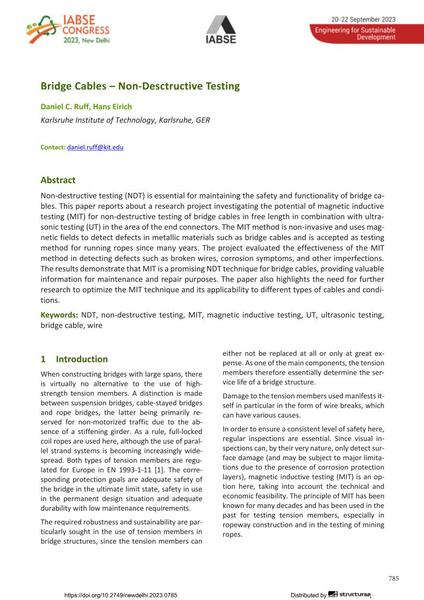Bridge Cables – Non-Desctructive Testing

|
|
|||||||||||
Bibliographic Details
| Author(s): |
Daniel C. Ruff
(Karlsruhe Institute of Technology, Karlsruhe, GER)
Hans Eirich (Karlsruhe Institute of Technology, Karlsruhe, GER) |
||||
|---|---|---|---|---|---|
| Medium: | conference paper | ||||
| Language(s): | English | ||||
| Conference: | IABSE Congress: Engineering for Sustainable Development, New Delhi, India, 20-22 September 2023 | ||||
| Published in: | IABSE Congress New Delhi 2023 | ||||
|
|||||
| Page(s): | 785-791 | ||||
| Total no. of pages: | 7 | ||||
| DOI: | 10.2749/newdelhi.2023.0785 | ||||
| Abstract: |
Non-destructive testing (NDT} is essential for maintaining the safety and functionality of bridge ca- bles. This paper reports about a research project investigating the potential of magnetic inductive testing (MIT} for non-destructive testing of bridge cables in free length in combination with ultra- sonic testing (UT} in the area of the end connectors. The MIT method is non-invasive and uses mag- netic fields to detect defects in metallic materials such as bridge cables and is accepted as testing method for running ropes since many years. The project evaluated the effectiveness of the MIT method in detecting defects such as broken wires, corrosion symptoms, and other imperfections. The results demonstrate that MIT is a promising NDT technique for bridge cables, providing valuable information for maintenance and repair purposes. The paper also highlights the need for further research to optimize the MIT technique and its applicability to different types of cables and condi- tions. |
||||
| Keywords: |
NDT non-destructive testing wire ultrasonic testing bridge cable MIT magnetic inductive testing UT
|
||||
